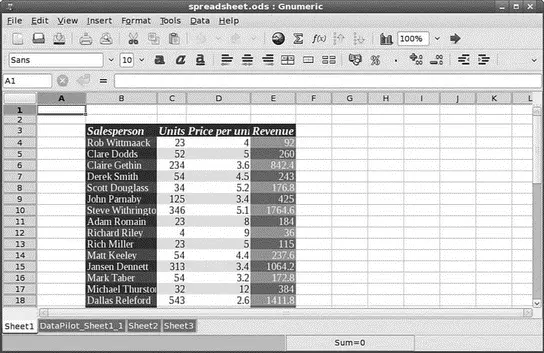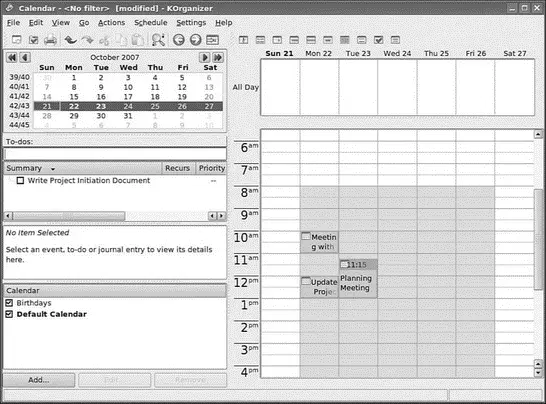You can use the Gnumeric spreadsheet application to perform financial calculations and to graph data, as shown in Figure 6.15. It can import comma- or tab-separated files, text, or files in the Gnumeric XML format, saving files only as XML or text. You need to install Gnumeric using either Add/Remove Software or the following command:
# yum install gnumeric
To launch Gnumeric from the menu, choose Applications, Office, Gnumeric Spreadsheet.

FIGURE 6.15 GNOME's Gnumeric is a capable financial data editor — here working with the same spreadsheet used earlier. OpenOffice.org also provides a spreadsheet application, as does KOffice.
After you press Enter, the main Gnumeric window appears. You enter data in the spread sheet by clicking a cell and then typing in the text box. To create a graph, you click and drag over the spreadsheet cells to highlight the desired data, and then you click the Graph Wizard icon in Gnumeric's toolbar. Gnumeric's graphing component launches, and you are guided through a series of dialogs to create a graph. When you have finished, you can click and drag a blank area of your spreadsheet, and the graph appears.
The Project Planner application is useful for tracking the progress of projects, much like its Windows counterpart, Microsoft Project. When the main window is displayed, you can start a new project or import an existing project. The application provides three views: Resources, Gantt Charts, and Tasks.
The KDE office suite KOffice was developed to provide tight integration with the KDE desktop. Integration enables objects in one application to be inserted in other applications via drag-and-drop, and all the applications can communicate with each other, so a change in an object is instantly communicated to other applications. The application integration provided by KDE is a significant enhancement to productivity. (Some GNOME desktop applications share a similar communication facility with each other.) If you use the KDE desktop rather than the default GNOME desktop, you can enjoy the benefits of this integration, along with the Konqueror web and file browser.
The word processor for KOffice is KWord. KWord is a frames-based word processor, meaning that document pages can be formatted in framesets that hold text, graphics, and objects in enclosed areas. Framesets can be used to format text on a page that includes columnar text and images that the text needs to flow around, making KWord an excellent choice for creating documents other than standard business letters, such as newsletters and brochures.
KWord and other components of KOffice are still under development and lack all the polished features of OpenOffice.org and AbiWord. However, it does have the ability to work with the OpenDocument format found in OpenOffice.org, as well as limited compatibility with Microsoft file formats.
You can access the KOffice components from the Office menu.
KWord asks you to select a document for your session. The KWord client, shown in Figure 6.16, offers sophisticated editing capabilities, including desktop publishing.

FIGURE 6.16 The KOffice KWord word processing component is a sophisticated frames- based WYSIWYG editor that is suitable for light desktop publishing, supporting several formats, including WordPerfect.
The KOffice KSpread client is a functional spreadsheet program that offers graphing capabilities. Like KWord, you can access KSpread from the Office menu.
KDE includes other productivity clients in its collection of KOffice and related applications. These clients include an address book, time tracker, calculator, notepad, and scheduler. One popular client is KOrganizer, which provides daily, weekly, work week, and monthly views of tasks, to-do lists, and scheduled appointments with background alarms. A journal, or diary, function is also supported within it, and you can synchronize information with your Palm Pilot. You can launch this client from the Office menu.
Figure 6.17 shows a typical KOrganizer window.

FIGURE 6.17 KDE's KOrganizer client supports editing of tasks and schedules that you can sync with your PDA.
Commercial Office Suites for Linux
Several commercial office suites are available for Fedora in addition to StarOffice, already mentioned. None of these commercial suites are provided with Fedora. Of note is Hancom Office. Using the same QT widget set found in the KDE desktop, Hancom Office scores well on Microsoft file format compatibility. The suite includes a word processor, a spreadsheet presentation tool, and a graphics application. Corel produced a version of its WordPerfect Office 2000 for Linux before it discontinued the release of any new Linux products. It still offers a support page, but the software is no longer available, nor is the excellent — but whiskered — WordPerfect 8 for Linux.
Productivity Applications Written for Microsoft Windows
Microsoft Windows is fundamentally different from Linux, but you can install and run some Microsoft Windows applications in Linux by using an application named Wine. Wine enables you to use Microsoft Windows and DOS programs on UNIX-based systems. Wine includes a program loader that you can use to execute a Windows binary, along with a DLL that implements Windows command calls, translating them to the equivalent UNIX and X11 command calls. Because of frequent updates to the Wine code base, Wine is not included with Fedora. Download a current version of Wine from http://www.winehq.org/. To see whether your favorite application is supported by Wine, you can look at the Wine application database at http://appdb.winehq.org/appbrowse.php.
In addition, there are other solutions to enable use of Microsoft productivity applications, primarily CodeWeavers' CrossOver Office. If you are after a painless way of running not only Microsoft Office, but also Apple iTunes and other software, you should really pay CodeWeavers a visit. CrossOver Office is one of the simplest programs you can use to get Windows-based programs to work. Check out http://www.codeweavers.com to download a trial version of the latest software. It requires registration, but don't worry—the guys at CodeWeavers are great and will not misuse your details. The big plus is that you get a whole month to play around with the trial before you decide whether to buy it. Of course, you might get to the end of the 30 days and realize that Linux does what you want it to do and you don't want to go back to Windows. Don't be afraid; take the plunge!
Relevant Fedora Commands
The following commands give you access to productivity applications, tools, and processes in Fedora:
► oowriter — OpenOffice.org's Writer
► oocalc — OpenOffice.org's Calc
► ooimpress — OpenOffice.org's Impress
► koshell — KDE's KOffice office suite shell
► kspread — KDE's KSpread spreadsheet
► gimp — The GIMP (GNU Image Manipulation Package)
► gnumeric — A spreadsheet editor for GNOME
► planner — A project management client for GNOME
Читать дальше








![Andrew Radford - Linguistics An Introduction [Second Edition]](/books/397851/andrew-radford-linguistics-an-introduction-second-thumb.webp)






